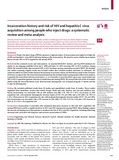Incarceration history and risk of HIV and hepatitis C virus acquisition among people who inject drugs: A systematic review and meta-analysis

View/Open
Date
2018-10-29Publisher
The LancetAuthor
Stone, JackFraser, Hannah
Lim, Aaron G
Walker, Josephine G
Ward, Zoe
MacGregor, Louis
Trickey, Adam
Abbott, Sam
Strathdee, Steffanie A
Abramovitz, Daniela
Maher, Lisa
Iversen, Jenny
Bruneau, Julie
Zang, Geng
Garfein, Richard S
Yen, Yung-Fen
Azim, Tasnim
Mehta, Shruti H
Milloy, Michael-John
Hellard, Margaret E
Sacks-Davis, Rachel
Dietze, Paul M
Aitken, Campbell
Aladashvili, Malvina
Tsertsvadze, Tengiz
Mravčík, Viktor
Alary, Michel
Roy, Elise
Smyrnov, Pavlo
Sazonova, Yana
Young, April M
Havens, Jennifer R
Hope, Vivian D
Desai, Monica
Heinsbroek, Ellen
Hutchinson, Sharon J
Palmateer, Norah E
McAuley, Andrew
Platt, Lucy
Martin, Natasha K
Altice, Frederick L
Hickman, Matthew
Vickerman, Peter
Metadata
Show full item recordCitation
Stone, J., Fraser, H., Lim, A. G., Walker, J. G., Ward, Z., MacGregor, L., . . . Vickerman, P. (2018). Incarceration history and risk of HIV and hepatitis C virus acquisition among people who inject drugs: A systematic review and meta-analysis. The Lancet Infectious Diseases, 18(12), 1397-1409. doi:10.1016/S1473-3099(18)30469-9Abstract
Background: People who inject drugs (PWID) experience a high prevalence of incarceration and might be at high risk
of HIV and hepatitis C virus (HCV) infection during or after incarceration. We aimed to assess whether incarceration
history elevates HIV or HCV acquisition risk among PWID.
Methods: In this systematic review and meta-analysis, we searched MEDLINE, Embase, and PsycINFO databases for
studies in any language published from Jan 1, 2000 until June 13, 2017 assessing HIV or HCV incidence among
PWID. We included studies that measured HIV or HCV incidence among community-recruited PWID. We included
only studies reporting original results and excluded studies that evaluated incident infections by self-report. We
contacted authors of cohort studies that met the inclusion or exclusion criteria, but that did not report on the outcomes
of interest, to request data. We extracted and pooled data from the included studies using random-effects meta-analyses
to quantify the associations between recent (past 3, 6, or 12 months or since last follow-up) or past incarceration and
HIV or HCV acquisition (primary infection or reinfection) risk among PWID. We assessed the risk of bias of included
studies using the Newcastle-Ottawa Scale. Between-study heterogeneity was evaluated using the I² statistic and the
P-value for heterogeneity.
Findings: We included published results from 20 studies and unpublished results from 21 studies. These studies
originated from Australasia, western and eastern Europe, North and Latin America, and east and southeast Asia.
Recent incarceration was associated with an 81% (relative risk [RR] 1∙81, 95% CI 1∙40–2∙34) increase in HIV
acquisition risk, with moderate heterogeneity between studies (I²=63∙5%; p=0∙001), and a 62% (RR 1∙62, 95% CI
1∙28–2∙05) increase in HCV acquisition risk, also with moderate heterogeneity between studies (I²=57∙3%; p=0∙002).
Past incarceration was associated with a 25% increase in HIV (RR 1∙25, 95% CI 0∙94–1∙65) and a 21% increase in
HCV (1∙21, 1∙02–1∙43) acquisition risk.
Interpretation: Incarceration is associated with substantial short-term increases in HIV and HCV acquisition risk
among PWID and could be a significant driver of HCV and HIV transmission among PWID. These findings support
the need for developing novel interventions to minimise the risk of HCV and HIV acquisition, including addressing
structural risks associated with drug laws and excessive incarceration of PWID.
